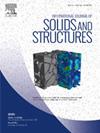A multiphysics framework for energy conversion from nonlinear electrostrictive dielectric elastomer generators
IF 3.4
3区 工程技术
Q1 MECHANICS
International Journal of Solids and Structures
Pub Date : 2025-03-18
DOI:10.1016/j.ijsolstr.2025.113345
引用次数: 0
Abstract
In this paper, we present a multiphysics framework for studying energy conversion from highly nonlinear electrostrictive dielectric elastomer generators. This framework investigates the impact of electrostriction on dielectric elastomers’ energy harvesting. Regarding the constitutive equations, we employ constitutive models which relate the dielectric permittivity of an elastomer to a general three-dimensional state of deformation based on the statistical mechanics of a Gaussian polymer chain. An in-house computer code is written based on the developed numerical framework. Two axisymmetric dielectric elastomer generators are studied: a circular diaphragm generator and a cylindrical tube generator. In this research, the case studies are diverse, though they focus on the electrostriction phenomenon. Our study demonstrates that the more negative (positive) the electrostrictive coefficient, the better (worse) the energy harvesting. More specifically, there exist cases in which we have improved the energy harvesting of the circular diaphragm generator and the cylindrical tube generator on average by 41.27, and 40.91 percent, respectively.
求助全文
约1分钟内获得全文
求助全文
来源期刊
CiteScore
6.70
自引率
8.30%
发文量
405
审稿时长
70 days
期刊介绍:
The International Journal of Solids and Structures has as its objective the publication and dissemination of original research in Mechanics of Solids and Structures as a field of Applied Science and Engineering. It fosters thus the exchange of ideas among workers in different parts of the world and also among workers who emphasize different aspects of the foundations and applications of the field.
Standing as it does at the cross-roads of Materials Science, Life Sciences, Mathematics, Physics and Engineering Design, the Mechanics of Solids and Structures is experiencing considerable growth as a result of recent technological advances. The Journal, by providing an international medium of communication, is encouraging this growth and is encompassing all aspects of the field from the more classical problems of structural analysis to mechanics of solids continually interacting with other media and including fracture, flow, wave propagation, heat transfer, thermal effects in solids, optimum design methods, model analysis, structural topology and numerical techniques. Interest extends to both inorganic and organic solids and structures.

 求助内容:
求助内容: 应助结果提醒方式:
应助结果提醒方式:


